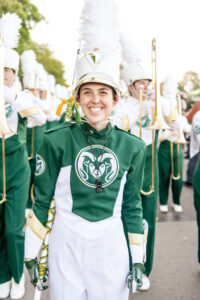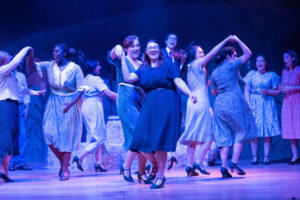Recorded music permeates our lives, shaping our moods, actions, and experiences in the spaces we inhabit, whether we realize it or not.
A new School of Music, Theatre, and Dance course, Music of the 20th and 21st Centuries (MU 430), offers music majors the opportunity to produce original ethnographic research, which includes observing or interacting with people moving through their chosen environments. The research took place online and in the Fort Collins community – settings where the students found music and/or sound to be an aspect of the human experience – including a local record store, The R Bar, a YouTube channel, and the Harbinger coffee houses.
Organized around the theoretical frames of semiotics and music, the students took field notes and conducted interviews on how music impacted people in those unique spaces.

Course instructor Dr. John Pippen explained, “Semiotics considers how something is always referencing something else. A picture of a horse, for example, is referencing a horse. Humans create all kinds of elaborate, shared, personal, and contradictory meanings via semiotics. The picture of the horse may call to mind a cherished memory for one person but for another a fear of large animals. Used in music, this gives students and researchers a way to engage all organized sound appropriately to its use and interpretation.”
The advanced project required considerable musical knowledge and incorporated secondary peer-reviewed literature relevant to the topic. Pippen was impressed by the theoretical depth of the papers, especially for an inaugural class.
Gathering Spaces
The Harbinger Coffee study was a joint project between CSU Honors students Lucy McCrossan, a senior in Music Education, and Olivia Colón, a senior Music Therapy student. A resulting podcast fulfilled an Honors Option for the course where an additional project, equivalent to one credit, enhances understanding of course material.
McCrossan’s paper, “Exploring the Impact of Music on Customer and Employee Satisfaction and Work Engagement in Coffee Shops,” asked, “How does the music played in coffee shops impact the overall coffee shop environment and customer and employee attitudes?” She spent two months observing the music at Harbinger Coffee in Fort Collins, Colorado, where she examined the implications music had on establishing a warm, inviting environment.

McCrossan noted that in Marek Korczynski’s paper “Music at Work: Towards a Historical Overview,” he described “how the use of upbeat music allows for ‘snappy bodily movements’ and that the use of personal music allows workers to better manage stressful situations.” She noted evidence of this while at Harbinger. Her paper argues that “the use of upbeat, popular music along with the ability for employees to choose the music played in coffee shops appeals to both customers and employees and allows for an increased sense of engagement in work.”
The ethnographic study allowed McCrossan to be more involved with the community she observed. She said, “By going to Harbinger and talking with their employees, I immersed myself in the environment more effectively. It can be challenging to truly connect and immerse yourself in a community you are researching, and an ethnography allows for a more personable approach in conducting research.”
“Working with Olivia [provided] a wider perspective on how the music at Harbinger enhances the coffee shop experience,” McCrossan said. “Olivia noticed more use of relaxing, indie music in the shop, which is interesting to consider compared to the more upbeat, pop music I observed.”
Similarly, Colón said, “The opportunity to expand each other’s knowledge on things we didn’t initially pick up on was so fascinating. It helped me gain a more holistic and cohesive understanding of the site.”
Colón’s paper, “An Exploration of How Music Influences Coffee Shop Flow,” considered how “music contributes to the flow and framework of a coffee shop.”
Colón said, “In coffee shops, music, and sounds seem to take a backseat for those in the shop. During my research, I discovered that the music is chosen to best fit and cater to the environment and express the employees’ taste in music.”
From her research, Colón noted that in Ha-Won Jang and Soo-Bum Lee’s article, “Applying Effective Sensory Marketing to Sustainable Coffee Shop Business Management,” they touch on how music influences customers. A part of Colón’s research involved discussions about what types of music should be played to create a customer-friendly environment.
Colón said, “People came to work or have conversations [at Harbinger], and the chosen music did not disrupt that flow or ability to do those things. The music was rarely distracting, and customers could go about their tasks easily.”
The Third Space
Several students looked closely at how music affected the environment in which they conducted their research.
Senior music major, Shawn Murphy’s paper, “Pride and Joy: An Ethnographic Study of a Gay Bar,” argued that “music within gay bars plays a key role in allowing people to express their identities as well as form community bonds within the space.”
Murphy’s research was conducted at The R Bar and Lounge. He modeled his participation after that of the other patrons. Murphy said, “Since the bar is a safe space for a marginalized community, it was important that I prioritized their comfort.”
Murphy modeled ethnographic methods, asking the bartenders and patrons questions about the bar and conducting a formal interview with the owner and creator of the safe space, Leanna Valadez.
Murphy’s paper states, “For a community of people to truly thrive, there must be spaces in which people can casually gather and socialize.” Music has long been a means of socializing for groups across many demographics.
Retail Spaces
Senior Music Education student, Lincoln Brandt’s paper, “Downtown Sound: Independent Record Stores and Vinyl Dreams,” explored Downtown Sound, an independent record and Hi-Fi store in Loveland. Lincoln observed the owner, John Jakow, and his son, Ben Jankow, interacting with customers, pricing and organizing records or audio equipment, and playing music throughout the retail environment.
In his paper, Brandt argues that “keeping the store open and functioning is a constant negotiation between the possible and the actual as explained by Thomas Turino in his book Music as Social Life.”
“For the first time in my academic life, I got to participate in something like original research,” Lincoln said. “Instead of merely reading and summarizing existing literature, I got to respond to it with knowledge gained from my own experience, which was incredibly rewarding.”
While conducting his research, Brandt noted that “an employee compared the store to an ‘affordable museum.’” When reading the secondary literature used for the paper, Brandt found a paper that directly compared used record shops to museums and used museum vocabulary to talk about the value used record stores bring to the world. “This was very encouraging and let me know my research was on the right track,” said Brandt.

In Aspen Ulibarri’s paper, “Background Music and Tangibility: The Importance of Atmosphere in a Bookstore,” she looked at “background music in retail and tangibility on purchase intentions for buying ebooks.” The research explored how high-fidelity background music and live presentational music affect a customer’s “compulsions to buy or stay longer in a store.”
The junior Music Education major’s research was conducted at a local Barnes & Noble.
Ulibarri noted, “Secondary research says that the time, pitch, and texture of music affect and influence our mood, associations with a store, and even our perceptions of time. For instance, faster music can be associated with happy feelings while slower music can be associated with more solemn or tranquil feelings.”
Ulibarri’s research describes how atmospheric effects impact our perceptions and associations in a retail setting. “The music at my field site seemed to help create a positive association with the store compared to other retail settings,” she said.
From Physical Space to Virtual Space

In Junior Music Performance major, Erin Wilson’s paper, “Visualizing Music: An Ethnographic Study,” she looked at “the key inspirations behind the creation of animated score visualizers.” One such visualizer that Wilson looks at is one found on the YouTube channel “Smalin,” authored by composer and software engineer Stephen Malinowski.
Wilson argues that the animated score visualizers, as seen on Malinowski’s channel and produced by his Music Animation Machine software, “allows for easier pattern recognition among viewers and a quicker digestion of the music.”
Wilson used semiotics to “explore the values viewers find in Smalin’s channel,” arguing that the language used in the comments “reflects deeper emotional connections to the music.”
Wilson’s research gave insight into the thriving online music communities and how technology fosters music education.
Because Wilson’s research was in an online space, she conducted her interview over Zoom. “Smalin had some inspiring things to say about music education and seemed super excited to find out how he could spread awareness of music notation animation to more educational institutions,” said Wilson.
Wilson described how a viewer can follow Smalin’s animated melodic line on the screen while it is being played. “When a pitch goes higher, the notated line will rise higher on the screen in the animation. When a pitch goes lower, the notated line will lower on the screen. With these visual cues, it can be easier to identify where a melodic line is moving,” said Wilson.
Wilson sees any connection someone makes between their personal life and music as “extra-musical.” She said, “Sound doesn’t have a feeling, scientifically, but we as humans associate certain emotional reactions to certain experiences, making the music much more than sound.”
Although the fall class is for music majors, Dr. Pippen noted that it facilitates inquiry into musical activities not covered elsewhere in their degrees. “Even a modest-sized city like Fort Collins is filled with an overwhelming amount of music. When they set out to empirically study that, they can experience the density of music in a personal and visceral way,” said Pippen. “There is so much music in the world, and the project shows students that.”